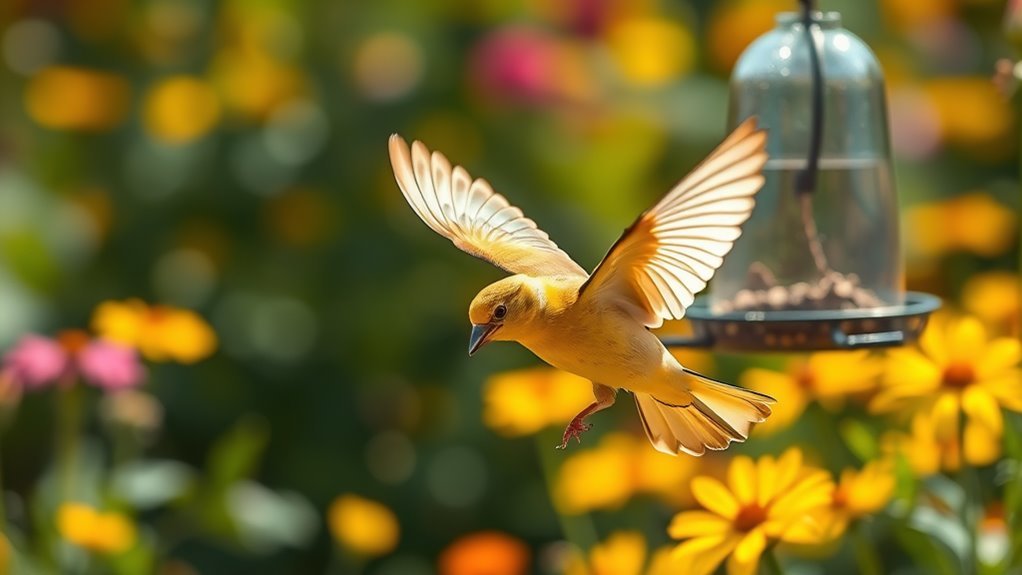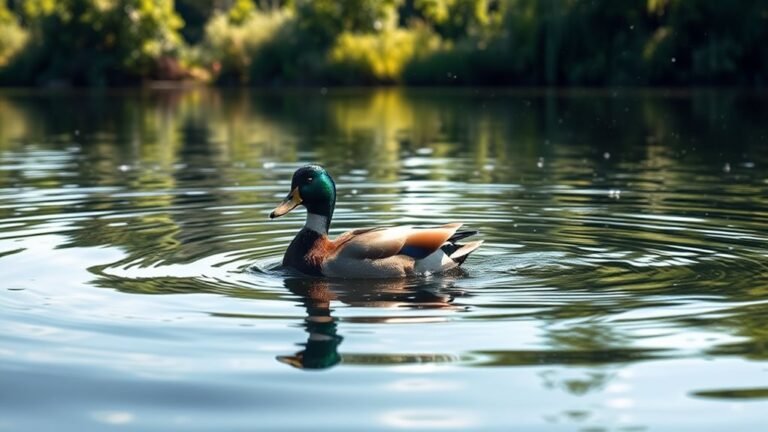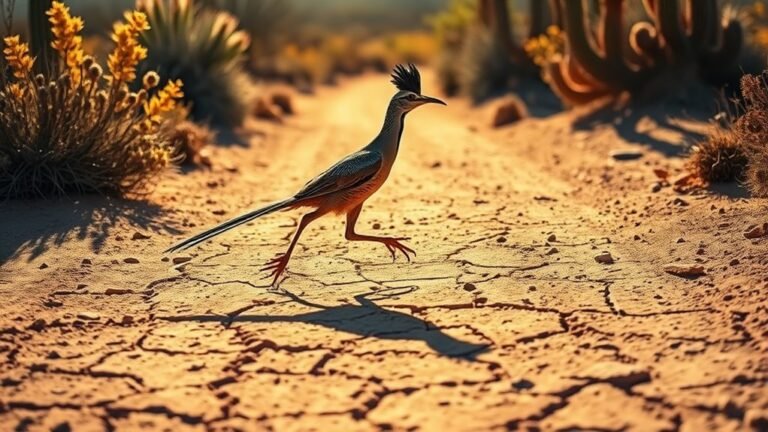Fascinating Facts About Goldfinches
Goldfinches show strong adaptability in their behavior. Their feathers change color with the seasons, which impacts their mating and survival. They eat seeds that are high in oil, demonstrating care in their food choices. Their social behavior and flying patterns influence how they interact and survive. What can we learn about how they build nests and communicate? These aspects are important for their survival and social connections.
Key Takeaways
- Male goldfinches flaunt bright yellow plumage during breeding season to attract mates, transitioning to olive-brown for camouflage in autumn.
- Their diet mainly consists of high-oil seeds from thistles, dandelions, and sunflowers, showcasing selective feeding habits.
- Goldfinches are skilled acrobats in flight, performing agile maneuvers to evade predators with swift direction changes.
- They exhibit social behavior by flocking, enhancing safety through cooperative feeding and predator detection among group members.
- Nesting in spring, both parents are involved in raising chicks, with females incubating eggs and males defending territory.
Unique Plumage Changes Throughout the Year

Goldfinches change their plumage throughout the year. In the breeding season, male goldfinches display bright yellow feathers. This bright color helps attract mates.
As autumn arrives, their yellow feathers shift to a muted olive-brown. This change provides better camouflage and helps them survive winter.
These plumage changes indicate the birds' readiness to reproduce and affect their social interactions. Females also change their feathers to enhance camouflage while caring for their young.
These transformations highlight goldfinches' adaptability to their environment and their role in the ecosystem. Understanding these changes helps us appreciate these beautiful birds more.
Specialized Diet and Feeding Preferences
Goldfinches adapt their appearance and feeding strategy through changes in plumage.
They've specialized diets that help them select the right seeds for survival. Here are some key points about their feeding habits:
- Seed Preference: Goldfinches mainly eat thistle, dandelion, and sunflower seeds, which are high in oil content.
- Selective Feeding: These birds wait for the right moment to pick seeds that are ripe and packed with nutrients.
- Adapted Beaks: Goldfinches have conical beaks that help them extract seeds, making their feeding process efficient.
Watching these birds in action can be fascinating, as they show patience and skill in finding the best food sources.
Masterful Acrobats in Flight

Goldfinches are highly agile birds. They exhibit impressive flight as they move between different habitats. You can see them twist, turn, and hover while flying through trees or over open fields.
This agility helps them avoid predators and find food. Their light bodies and special wing shapes allow for quick changes in direction, helping them escape danger and land precisely on moving seed heads.
Observing their flight patterns provides insight into their survival tactics. These skills are essential for goldfinches in their daily lives. They truly are expert flyers.
Social Behavior and Flocking Strategies
Goldfinches often appear alone in backyards, but they usually thrive in groups. Observing how they interact in flocks provides insights into their social behavior.
Here are three key aspects of goldfinch behavior:
- Flocking for Safety: Groups of goldfinches can spot predators more easily. This teamwork helps them stay safe.
- Resource Sharing: When feeding together, goldfinches find food more efficiently. Working as a group increases their chances of success.
- Social Bonds: Goldfinches form strong connections with each other. These bonds create a supportive social network.
Understanding these behaviors can bring you closer to nature and enhance your appreciation for these lively birds.
Nesting Habits and Parenting

As spring arrives, goldfinches start nesting. They build their nests in shrubs or trees, choosing spots that provide shelter.
They collect materials like grasses, plant fibers, and spider silk, which they weave into strong nests.
During breeding season, both male and female goldfinches care for their young. The female incubates the eggs, while the male defends their territory.
After the chicks hatch, both parents search for seeds to feed their family, ensuring the young birds grow healthy and strong during this important time.
Vocalizations and Communication
Many birds use vocalizations to communicate, and goldfinches are no different. Their songs play a key role in their social interactions and serve various functions.
Goldfinches are known for their different calls and can mimic sounds from their environment. This ability may help them avoid predators or attract mates.
Here are three main types of their vocalizations:
- Mating Calls: Male goldfinches sing unique songs to show their fitness during courtship.
- Territorial Sounds: Goldfinches make calls to claim their territory and send rivals away.
- Contact Calls: They use simple, chirpy notes to stay in touch with their flock members.
Learning about these vocal patterns can help you appreciate goldfinches and their social behaviors.
Migration Patterns and Habitats
Goldfinches have clear migration patterns and specific habitat preferences that are important for their survival. These small birds mainly live in North America.
They migrate south in the winter to find warmer areas where food, such as sunflowers and thistles, is plentiful. In spring, they travel back north to breed.
They prefer open woodlands and fields abundant in seeds. Their movements depend on food availability, showing their ability to adapt.
Watching goldfinches as they move through their seasonal habitats connects you to nature. It also helps you understand their behaviors and survival methods better, increasing your appreciation for these colorful birds.
Frequently Asked Questions
What Is the Lifespan of a Goldfinch in the Wild?
Goldfinches in the wild usually live between 3 to 6 years. Their lifespan depends on several factors. Predators can pose a threat, while the availability of food and weather conditions also play a role in their survival. Understanding these factors helps us appreciate the challenges goldfinches face in nature.
How Do Goldfinches Attract Mates During Breeding Season?
During breeding season, goldfinches perform courtship displays. Males make unique mating calls and flutter their wings. These actions help males show their strength and attract females for reproduction.
Are Goldfinches Endangered or Threatened Species?
Goldfinches are not classified as endangered or threatened. However, they face challenges from habitat loss, which affects their numbers. Conservation efforts focus on protecting their natural habitats to help these colorful birds thrive. By preserving their environment, we can ensure that goldfinches continue to brighten our landscapes. Let's support actions that promote their well-being and keep these cheerful birds in our area for generations to come.
Can Goldfinches Recognize Individual Humans or Other Birds?
Goldfinches can identify individual humans and birds with regular interaction. Studies show they can learn unique features of different individuals. This ability helps them build lasting associations, which affect how they respond to people and birds over time.
What Predators Are Common Threats to Goldfinches?
Goldfinches face several common predators. Cats are a significant threat, as they hunt and kill these birds. Additionally, hawks and kestrels are avian predators that also target goldfinches. These predators affect the survival and behavior of goldfinches. Recognizing these threats helps us understand their resilience and adaptability in nature.

Hello, I’m Emily Price, the founder of Birds Affection. As a passionate bird enthusiast and spiritual seeker, I’ve always been fascinated by the symbolic meanings and mystical connections between birds and our lives. On this website, I share my knowledge and insights on the spiritual significance of various bird species, exploring their roles as messengers, guides, and teachers. Through my writing, I aim to inspire and educate others on the profound wisdom and beauty that birds bring to our world. Join me on this journey as we delve into the enchanting realm of bird symbolism and discover the hidden meanings behind these magnificent creatures.







